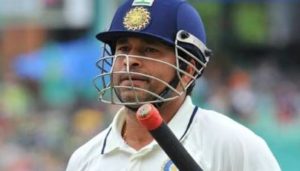
When Sachin Tendulkar began playing cricket, it used to be a different ball game altogether. In 1989, cricketers in India were allowed to fail without being judged.
Back in the day, there were no glaring eyes. People took cricket as just a sport before Tendulkar transformed that into a raging and burning passion. Within the first 10 years of Tendulkar’s career, it changed drastically. As Tendulkar started piling batting records, he unified the country of India into a nation, almost becoming its adopted son in a way. And wearing that tag with pride, Tendulkar went on to dominate bowling attacks en route to becoming the world’s greatest batter of his generation.
As Tendulkar’s career reached great heights, cricket in India became a record-obsessed sport. And in Sachin’s case, it was the fascination of wanting to see him score a century everytime he walked out to bat. So much so that there came a time when the notion stated ‘Everytime Tendulkar scored a century, India loses’, which by the way could not be any further from reality. Out of the 49 ODIs in which Tendulkar scored a century, India emerged victorious in 33, resulting into a win percentage of over 67 percent. But statistics aside, Tendulkar dealt with different kind of pressures in his career – injuries, captaincy, World Cup exits – but former India coach Ravi Shastri reckons none came close to the pressure of expectations Sachin dealt with.
“Every time he went out, you know, the entire nation would sit up and watch. When is he going to get a hundred? They treated it as his failure if he didn’t. I know he might have felt very lonely at times. When you reach those heights, it can be a very lonely place to be because you are the only one there who understands what’s happening,” Shastri said on ABC Australia’s documentary ‘Bradman and Tendulkar – the untold story of two of cricket’s giants’.
– ‘Even Siri doesn’t know where to bowl to Sachin’: Australia great’s ‘Tendulkar-centric’ obsession
Tendulkar, who began playing cricket at 16 and was called the child prodigy, took giant steps in his career with a match-saving maiden Test century at Manchester in 1990. But it was the tour of Australia two years later in 1992 that the world knew he was destined for greatness. Even thought Australia ran India ragged, Tendulkar stood tall and announced his true arrival with twin centuries – 148 in Sydney and a cracking 114 at WACA, Perth, the bounciest pitch in the world where the ball was simply flying around. Shastri, who was Tendulkar’s teammates during that tour, knew he was witnessing something mighty special.
“That’s when I first saw greatness from 22 yards. It is one thing getting runs and another thing watching a kid who is 18 years of age dominate an Australian attack like the way he did. You felt that this guy was in a different league now. This is where he’s moving from Tendulkar towards Bradman,” he added.
Shastri was one of the best judges of Tendulkar’s early potential as the two shared India’s dressing room when Sachin made his international debut. The tale of Tendulkar copping a blow off a steaming Waqar Younis delivery leaving him with a bloodied nose is well known, but the moment Sachin, in his squeaky voice said ‘Main khelega‘ (I will bat on), straight drove the next ball for four, Shastri saw a tenacity like no other.
“By the time he was 16, he might have played more matches than any 22-23 year-old. When he played his first Test, he was in overdrive already. And then to go and play the pace attack like that – Imran, Wasim, Waqar – he just battled through,” he mentioned




 Driving Naari Programme launched in Chandigarh
Driving Naari Programme launched in Chandigarh






























